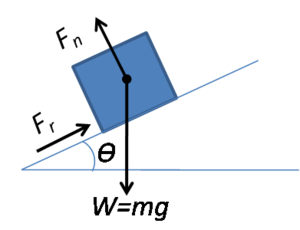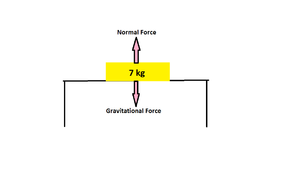Compression or Normal Force: Difference between revisions
Patrycjakot (talk | contribs) (I am correcting the equations and defining variables.) |
Patrycjakot (talk | contribs) No edit summary |
||
| Line 4: | Line 4: | ||
==Compression of Normal Force== | ==Compression of Normal Force== | ||
The compression or also commonly known as the normal force, <math> F_n\ </math>, is a simple fundamental concept that must be understood before attempting any contact force problem. First, it is important to understand that the normal force is NOT a kind of fundamental force such as the electric or gravitational force. It is just a force used to describe the interaction between atoms. As hinted by the name, this force simply points in the perpendicular or "normal" direction to the surface(s) that it is in contact with. The magnitude of this normal force often equal to the weight of the object, however, | The compression or also commonly known as the normal force, <math> F_n\ </math>, is a simple fundamental concept that must be understood before attempting any contact force problem. First, it is important to understand that the normal force is NOT a kind of fundamental force such as the electric or gravitational force. It is just a force used to describe the interaction between atoms. As hinted by the name, this force simply points in the perpendicular or "normal" direction to the surface(s) that it is in contact with. The magnitude of this normal force is often equal to the weight of the object, however, objects can move at various angles, therefore resulting in the normal force to | ||
Understanding information about the normal force on an object can also help . The approximate force of friction is the static friction coefficient multiplied by this normal force. | Understanding information about the normal force on an object can also help . The approximate force of friction is the static friction coefficient multiplied by this normal force. | ||
| Line 39: | Line 39: | ||
===Simple=== | ===Simple=== | ||
[[File: ExampleNorm1.png|left|thumb|Example 1]] | [[File: ExampleNorm1.png|left|thumb|Example 1]] | ||
| Line 51: | Line 52: | ||
====Answer==== | ====Answer==== | ||
Fn = mgcos(theta) | |||
In this example, theta will be 90 since the normal force is perpendicular to the surface that it is resting on, thus 90 degrees. | In this example, theta will be 90 since the normal force is perpendicular to the surface that it is resting on, thus 90 degrees. | ||
Now we can plug into our formula: | Now we can plug into our formula: | ||
| Line 86: | Line 87: | ||
==History== | ==History== | ||
[[Media:]] | |||
[[File:Newton12.jpg|right|thumb|Sir Issac Newton]] | [[File:Newton12.jpg|right|thumb|Sir Issac Newton]] | ||
The normal force a direct application of Newton's Third Law of Motion. | The normal force a direct application of Newton's Third Law of Motion. Sir Issac Newton was a famous scientist from England who roamed the Earth from 1643 to 1727. His work in math and physics set the stage for many of the principles and theories that we have today. His main work, the Philosophiae Naturalis Principia Mathematic, discussed many of his theories about physics and stated his three laws of motion. The application of Newton's three laws of motion extend to today's uses due to the important of understanding how much | ||
== See also == | == See also == | ||
| Line 103: | Line 104: | ||
==References== | ==References== | ||
Information: | Information: | ||
https://en.wikipedia.org/wiki/Normal_force | https://en.wikipedia.org/wiki/Normal_force | ||
| Line 111: | Line 113: | ||
Images: | Images: | ||
https://en.wikipedia.org/wiki/Normal_force#/media/File:Friction_relative_to_normal_force_(diagram).png | https://en.wikipedia.org/wiki/Normal_force#/media/File:Friction_relative_to_normal_force_(diagram).png | ||
https://en.wikipedia.org/wiki/Philosophiæ_Naturalis_Principia_Mathematica | |||
http://www.sparknotes.com/physics/dynamics/newtonapplications/section1.rhtml | http://www.sparknotes.com/physics/dynamics/newtonapplications/section1.rhtml | ||
[[Category: Contact Interactions]] | [[Category: Contact Interactions]] | ||
Revision as of 19:15, 16 April 2016
Claimed by Hemanth Koralla

Compression of Normal Force
The compression or also commonly known as the normal force, [math]\displaystyle{ F_n\ }[/math], is a simple fundamental concept that must be understood before attempting any contact force problem. First, it is important to understand that the normal force is NOT a kind of fundamental force such as the electric or gravitational force. It is just a force used to describe the interaction between atoms. As hinted by the name, this force simply points in the perpendicular or "normal" direction to the surface(s) that it is in contact with. The magnitude of this normal force is often equal to the weight of the object, however, objects can move at various angles, therefore resulting in the normal force to
Understanding information about the normal force on an object can also help . The approximate force of friction is the static friction coefficient multiplied by this normal force.
Equations
The formula for calculating the normal force at an angle is:
- [math]\displaystyle{ F_n = mg \cos(\theta) }[/math]
- [math]\displaystyle{ F_n }[/math] is the normal force present in the system
- [math]\displaystyle{ m }[/math] is the mass of the system
- [math]\displaystyle{ g }[/math] is a constant value for the force due to gravity and is equivalent to 9.8 [math]\displaystyle{ m/s^2 }[/math]
- [math]\displaystyle{ \theta }[/math] is the angle of the incline (
The normal force of an object (such as a block) on an inclined plane must be separated into parallel and perpendicular components. This results in two separate equations for the normal force on the object.
- Perpendicular component of normal force:
- [math]\displaystyle{ F_n = mgcos(\theta) }[/math]
- [math]\displaystyle{ m }[/math] is the mass of the object
- [math]\displaystyle{ g }[/math] is the force of gravity and is equivalent to [math]\displaystyle{ 9.8 m/s^2 }[/math]
- [math]\displaystyle{ \theta }[/math] is the angle of the incline
- Parallel component of normal force (with no friction present):
- [math]\displaystyle{ F_n = mgsin(\theta) }[/math]
- [math]\displaystyle{ m }[/math] is the mass of the object
- [math]\displaystyle{ g }[/math] is the force of gravity and is equivalent to [math]\displaystyle{ 9.8 m/s^2 }[/math]
- [math]\displaystyle{ \theta }[/math] is the angle of the incline
The formula for calculating the force of friction using this normal force when an object is on an inclined plane is:
- [math]\displaystyle{ F_f (static) = \mu_k F_n }[/math]
- [math]\displaystyle{ = \mu_k (mg \cos(\theta)) }[/math]
Examples
Time for a few examples:
Simple

On the image to the left (Example 1), there is a 7 kilogram block resting on top a flat table. Find the normal force, [math]\displaystyle{ F_n\ }[/math], that is being exerted on the block. The force of gravity is 9.8 N/kg.
Answer
Fn = mgcos(theta) In this example, theta will be 90 since the normal force is perpendicular to the surface that it is resting on, thus 90 degrees. Now we can plug into our formula: m = 7kg g = 9.8 N/kg theta = 90
Fn = (7 kg)(9.8 N/kg)cos(90) = 68.6 N
Middling

In Example 2 (the figure to the right), the 14 kg block is lying stationary on a plane that is inclined 48 degrees. Find the normal force perpendicular to the block on the incline. The force of gravity is 9.8 N/kg.
Answer
Because this problem asks for the normal force on an inclined plane, it is important to break up the normal force into components: Given:
m = 14 kg g = 9.8 N/kg theta = 48
Using trigonometry, it is seen that the cosine trig identity correlates to
Fn = mgcos(theta) Fn = (14 kg)(9.8 N/kg)cos(48) = 91.805 N
Connectedness
This force is pretty important to understand because it explains the fundamental reason for why gravity doesn't keep pulling us down and explains this not-so-apparent force that is acting on an object. It helps explain why we don't keep falling into the Earth. The application of the normal force can be seen in many industrial situations. It must be taken into account when creating any free body diagram or any construction.
History
[[Media:]]
The normal force a direct application of Newton's Third Law of Motion. Sir Issac Newton was a famous scientist from England who roamed the Earth from 1643 to 1727. His work in math and physics set the stage for many of the principles and theories that we have today. His main work, the Philosophiae Naturalis Principia Mathematic, discussed many of his theories about physics and stated his three laws of motion. The application of Newton's three laws of motion extend to today's uses due to the important of understanding how much
See also
External links
http://hyperphysics.phy-astr.gsu.edu/hbase/frict.html
http://www.physicsclassroom.com/class/newtlaws/Lesson-2/Types-of-Forces
https://www.physics.uoguelph.ca/tutorials/fbd/FBD3.htm
References
Information:
https://en.wikipedia.org/wiki/Normal_force
http://www.sparknotes.com/physics/dynamics/newtonapplications/section1.rhtml
http://hyperphysics.phy-astr.gsu.edu/hbase/thermo/thereq.html
Images:
https://en.wikipedia.org/wiki/Philosophiæ_Naturalis_Principia_Mathematica
http://www.sparknotes.com/physics/dynamics/newtonapplications/section1.rhtml